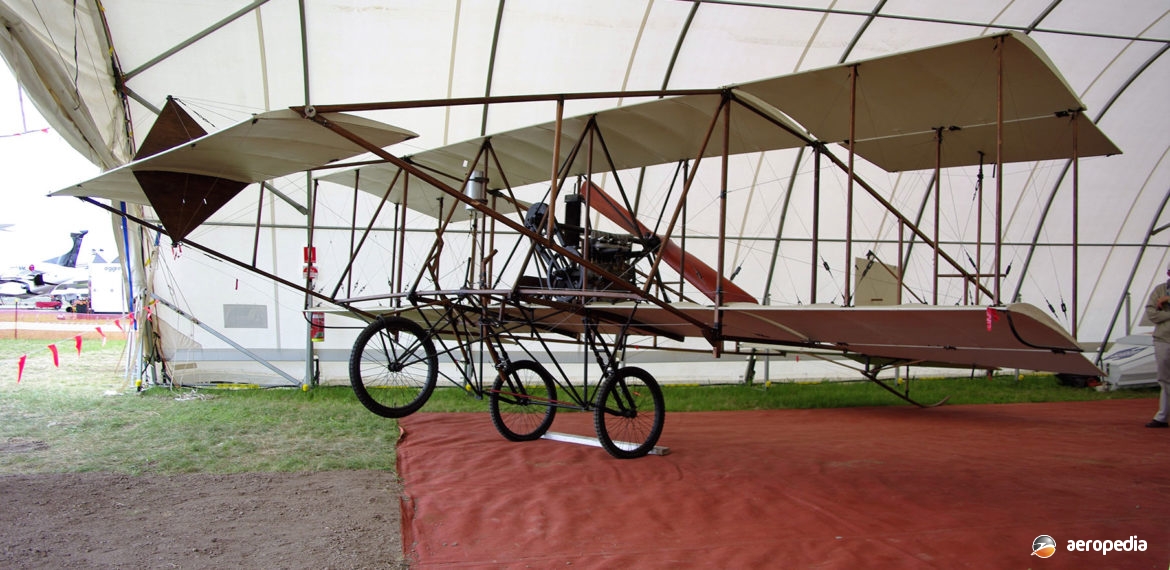Photograph:
Duigan biplane replica VH-DGN³ (c/n 1910) at Avalon, VIC in 2011 (David C Eyre)
Country of origin:
Australia
Description:
Single-seat biplane
Power Plant:
One 18.6 kw (25 hp) [at 1,800 rpm] Tilley four-cylinder vertical liquid-and-air-cooled engine
Specifications:
- Wingspan: 7.5 m (24 ft 6 in)
- Chord: 1.07 m (3 ft 6 in)
- Length: 10.7 m (35 ft)
- Front elevator: 3.7 m (12 ft) x 0.76 m (2 ft 6 in)
- Rear elevator: 3.7 m (12 ft) x 1.07 m (3 ft 6 in)
- Max speed: 72 km/h (45 mph)
- Take-off run in 6 km (4 mph) wind: 91 m (300 ft)
- Empty weight: 227 kg (500 lb)
- Loaded weight: 286 kg (630 lb)
History:
The Duigan biplane was designed and built by John and Reginald Duigan on a farm 128 km (80 miles) from Melbourne, VICand was the first aircraft to be designed and built in Australia. Every part of the machine was constructed by the brothers, and materials used included Australian mountain ash and red pine. The bands from wool bales were machined into sheet metal fittings as required. No glue or nails were used, as all sections were bolted. Piano wire was used instead of struts, although the wire was replaced by wooden struts later. The wires were only used in tension to maintain the effective shape of the framework and to transmit lift. Everything was tested to destruction before it was used. John Duigan designed a propeller 2.59 m (8 ft 6 in) in diameter.
Viewed from the side the aircraft consisted of a leading elevator plane (controllable), a fixed lifting plane of approximately the same size and construction, then two biplane lifting wings with upturned outer ends to give a degree of automatic lateral stability, and a trailing tailplane (fixed) with the same general dimensions as the front elevator. Attached to the trailing-edge of this tailplane was an elevator flap, working in conjunction with the leading elevator plane, so that one controlling movement elevated the front of the machine and depressed the rear, or vice versa.
Two mainwheels were placed under the mainplanes, a light castering wheel under the tailplane, and a light bicycle wheel in front of the main wheels. Experiments led to the front elevator being moved nearer to the main wheels, reducing the length to 8.7 m (28 ft 6 in), and the fixed lifting plane was eliminated. Two small balancing planes fitted between the wing-ends, and acting in opposition, were discarded, and four trailing flaps, or ailerons, were substituted. The main wings were then 7.5 m (24 ft 6 in) across.
All covering on the aircraft was a light, rubber-coated fabric made by the Dunlop Rubber Company specially for the aircraft. Some modifications were necessary to the engine to make it suitable, and the original drive to the propeller was by a V-belt of rubberised leather.
On 16 July 1910 John Duigan made a cautious flight of 7 m (24 ft) but found the engine was losing too much power, so he re-bored the crankcase and installed larger cylinders, changing from air to liquid cooling, built a radiator, and changed to chain drive. With the modified engine he made a number of flights of up to 183 m (600 ft) but only with an altitude of some 3.05 m to 4.6 m (10 ft to 15 ft).
At about the same time Reginald Duigan had started flying the machine, completing a 549 m (1,800 ft) flight. On 3 May 1911, five flights were made at the Epsom race-course in Melbourne in front of a large crowd, with a height of 18 m (60 m) and a maximum distance of 914 m (3,000 ft) being attained.
Thankfully, this aircraft was preserved for future generations to see and was placed on display at the Institute of Applied Science in Melbourne but in later times it was placed in storage.
A replica of this aircraft was built by Mr Ronald Lloyd Lewis (1919-1995), an RAAF aircraftsman in Victoria. It was allotted the registration VH-DGN² (c/n RM-1) on 11 Mayn 1992 and for a time was on display in a hangar at Mangalore Airport, VIC. However, Mr Lewis passed away before the aircraft could be flown. It was eventually gifted to the Melbourne Museum and placed on display in the Gremde Galleria on 1 July 2000, the registration being revoked on 27 June 2006.
In December 2010 a flying replica was registered to its builder, this aircraft being built by a team led by Terence Egan of Geelong, VIC for the centenary of the flight of the original aircraft. When completed it became VH-DGN³ (c/n 1910) on 10 December 2010 and was taken to a sports oval at Mia Mia, VIC near where the original aircraft was flown. But it was never flown. For a period it was placed on dislay at the Wagga Wagga, NSW airport terminal on loan from its owner. It was placed on display at the Australian International Airs Show at Avalon, VIC in 2011 and has since been placed on display at the Australian National Aviation Museum at Moorabbin, VIC.

